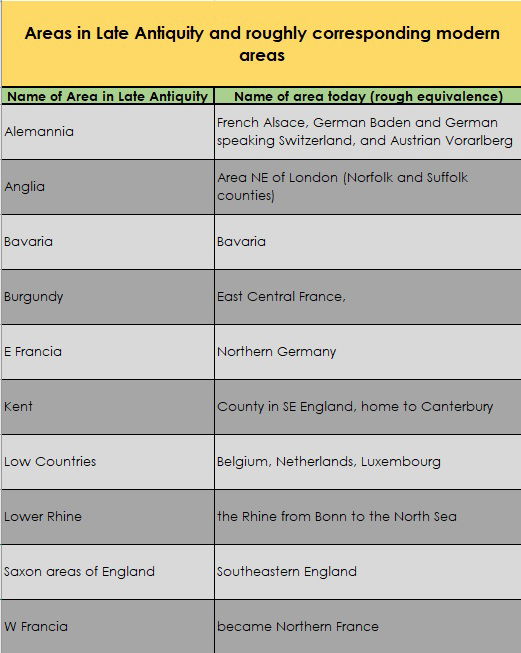TWH – Most ancient rituals have left no traces that have survived. Burial rituals differ. Those rituals leave corpses. Sometimes they leave structures. Sometimes they bury objects, known as “grave goods,” with the deceased.
A recent article by Dr. Emma Brownlee, “Grave Goods in Early Medieval Europe: regional variability and decline” examines changes in burials along the northwestern Romano-Germanic frontier. Brownlee studied the changes that occurred between roughly 500 and 800 C.E.

Rhine River
During this period, burial practices changed along that frontier. According to the website, Phys.org, Brownlee said “Almost everyone from the eighth century [the 700s] onwards is buried very simply in a plain grave, with no accompanying objects, and this is a change that has been observed right across western Europe.”
According to Brownlee, this study showed the interdependence of northwestern Europe.
While Brownlee did not discuss possible evidence for survival of pagan burial rituals, her study might shed light on that survival.
Context
Two events bookended that 300-year period. It began with the collapse of the Western Roman Empire. The world of the ancient western Mediterranean had ended. That 300-year period ended with the dominance of the Frankish Empire. Medieval Europe had begun.
Brownlee focused on the geographic locations of cemeteries. She decided against linking cemeteries to specific political or social entities. Boundaries were constantly shifting in this period.
Evidence of grave goods
Brownlee has identified 10 categories of grave goods. Grave goods refer to objects buried with the deceased.

She also identified 11 regions along that frontier.

Cemeteries in general
The majority of cemeteries along this frontier had grave goods from 500 to 699 CE. Cemeteries tended to contain graves both those with grave goods and those without. After roughly 700 CE, grave goods became very rare.
In most areas, declines in the use of grave goods occurred gradually. In areas like Kent, the Low Countries, and Western Francia, people abruptly abandoned the custom of grave goods soon after 700 CE. As grave goods disappeared, shrouded burials became more common.
The number of graves in these cemeteries differs from the estimated nearby population. That difference could mean that most people lacked access to this type of burial. Some graves may remain undiscovered, others may have failed to survive. Some people may have had “informal” burials.
Poorer people, however, would probably be reluctant to bury things of value in graves. Those things of value include jewelry, tools, and weapons. These “formal” cemeteries could be those of people who held a high status.
Regions with a gradual decline in the presence of grave goods in cemeteries
Alemannia
In Alemannia, grave goods were commonly found. Graves averaged three to four objects as grave goods per grave. Grave goods included the following: dress accessories, fittings, jewelry, and personal accessories. At least 35% of graves in a cemetery contained dress accessories. Objects that were rarely found in other regions were more common in Alemannia. These included amulets, animal remains, and tools. People frequently buried weapons with the deceased.
Anglia
In almost all Anglian cemeteries, graves had an average of three to four objects per grave. In Anglia, 50 to 75% of graves had dress accessories. Archaeologists rarely found amulets, animal remains, coins, and tools.
Bavaria
Burials occurred intermittently in Bavarian cemeteries. Years might pass between burials. The types of grave goods found remained fairly constant over 300 years. Rarely did archaeologists find animal remains, coins, and tools. The number of dress accessories declined.
Burgundy
Cemeteries in Burgundy had few graves with grave goods. Unlike in other regions, its graves seldom contained personal accessories. In few cemeteries did more than 25% of the graves contain personal accessories. More graves contained dress accessories. Graves rarely contained amulets, animal remains, jewelry, tools, or vessels or weapons.
Eastern Francia
Eastern Francia had broad fluctuations in grave goods. Although rare, animal remains were found in grave more often in eastern Francia than in other regions.
The Lower Rhine
The number of grave goods varied in the Lower Rhine. People had buried more dress accessories than personal accessories. In most cemeteries, at least 35% of graves contained vessels.
The Saxon areas of Britain
The Saxon areas of Britain had less variation in grave goods than other regions did. A large number of burials had “a modest number of grave goods.” Some grave goods were animal remains. In 40 to 60% of graves, mourners had buried personal accessories. Dress accessories were found about as often as personal accessories.
Some regions had an abrupt decline in the presence of grave goods
In Kent, the Low Countries, and western Francia, no gradual decline in grave goods occurred. Instead, people suddenly abandoned the use of grave goods. That abandonment occurred sometime between the late 600s and the early 700s. Brownlee described this sudden abandonment as “an intentional step to bring funerary practice in line with that in the rest of north-western Europe.”
Kent
Kent had great variety in the numbers of its grave goods. Mourners buried roughly the same amount of grave goods in Kent that they did in the Saxon region. By comparison with the other Germanic tribes in Britain, Kent tended to resist change. Cemeteries in Kent had few vessels.
The Low Countries
Archaeologists found fewer grave goods in the Low Countries than they did in other regions. The average number of grave goods varied. Graves contained many vessels.
Western Francia
Western Francia had fewer grave goods than other regions. The following types of grave goods were rare: amulets, amulets, jewelry, tools, and weapons.
A special relationship
Evidence exists of political and social contact between Kent and western Francia. According to Frankish sources, a Frankish elite had political control of Kent. Royal intermarriages did occur between western Francia and Kent. Among the Anglo-Saxon areas of Britain, only Kent frequently imported French luxury goods.
At present, no one know for certain what meaning people gave to these grave goods. As they buried them with the dead, they must have had some importance. Without their ritual and myths, modern Pagans cannot know with certainty what meaning or importance those grave goods had. But modern Pagans can imagine.
The Wild Hunt is not responsible for links to external content.
To join a conversation on this post:
Visit our The Wild Hunt subreddit! Point your favorite browser to https://www.reddit.com/r/The_Wild_Hunt_News/, then click “JOIN”. Make sure to click the bell, too, to be notified of new articles posted to our subreddit.
